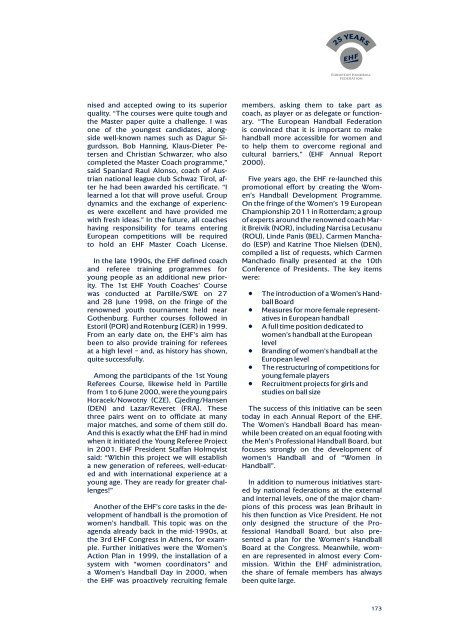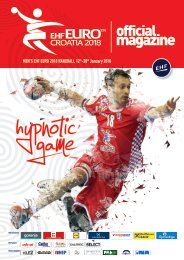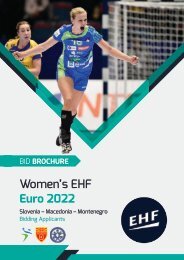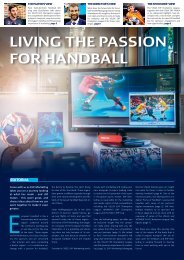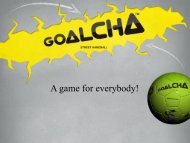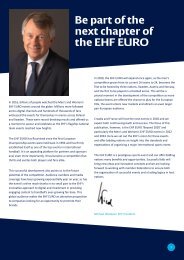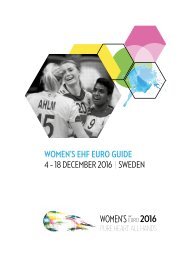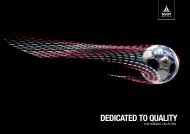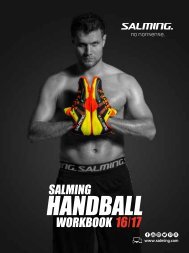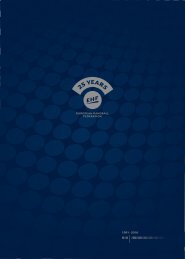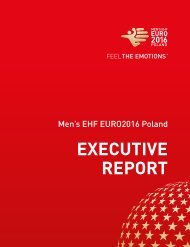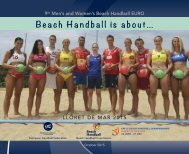ehf_25yers_book_webversion (1)
You also want an ePaper? Increase the reach of your titles
YUMPU automatically turns print PDFs into web optimized ePapers that Google loves.
nised and accepted owing to its superior<br />
quality. “The courses were quite tough and<br />
the Master paper quite a challenge. I was<br />
one of the youngest candidates, alongside<br />
well-known names such as Dagur Sigurdsson,<br />
Bob Hanning, Klaus-Dieter Petersen<br />
and Christian Schwarzer, who also<br />
completed the Master Coach programme,”<br />
said Spaniard Raul Alonso, coach of Austrian<br />
national league club Schwaz Tirol, after<br />
he had been awarded his certificate. “I<br />
learned a lot that will prove useful. Group<br />
dynamics and the exchange of experiences<br />
were excellent and have provided me<br />
with fresh ideas.” In the future, all coaches<br />
having responsibility for teams entering<br />
European competitions will be required<br />
to hold an EHF Master Coach License.<br />
In the late 1990s, the EHF defined coach<br />
and referee training programmes for<br />
young people as an additional new priority.<br />
The 1st EHF Youth Coaches’ Course<br />
was conducted at Partille/SWE on 27<br />
and 28 June 1998, on the fringe of the<br />
renowned youth tournament held near<br />
Gothenburg. Further courses followed in<br />
Estoril (POR) and Rotenburg (GER) in 1999.<br />
From an early date on, the EHF’s aim has<br />
been to also provide training for referees<br />
at a high level – and, as history has shown,<br />
quite successfully.<br />
Among the participants of the 1st Young<br />
Referees Course, likewise held in Partille<br />
from 1 to 6 June 2000, were the young pairs<br />
Horacek/Nowotny (CZE), Gjeding/Hansen<br />
(DEN) and Lazar/Reveret (FRA). These<br />
three pairs went on to officiate at many<br />
major matches, and some of them still do.<br />
And this is exactly what the EHF had in mind<br />
when it initiated the Young Referee Project<br />
in 2001. EHF President Staffan Holmqvist<br />
said: “Within this project we will establish<br />
a new generation of referees, well-educated<br />
and with international experience at a<br />
young age. They are ready for greater challenges!”<br />
Another of the EHF’s core tasks in the development<br />
of handball is the promotion of<br />
women’s handball. This topic was on the<br />
agenda already back in the mid-1990s, at<br />
the 3rd EHF Congress in Athens, for example.<br />
Further initiatives were the Women’s<br />
Action Plan in 1999, the installation of a<br />
system with “women coordinators” and<br />
a Women’s Handball Day in 2000, when<br />
the EHF was proactively recruiting female<br />
members, asking them to take part as<br />
coach, as player or as delegate or functionary.<br />
“The European Handball Federation<br />
is convinced that it is important to make<br />
handball more accessible for women and<br />
to help them to overcome regional and<br />
cultural barriers,” (EHF Annual Report<br />
2000).<br />
Five years ago, the EHF re-launched this<br />
promotional effort by creating the Women’s<br />
Handball Development Programme.<br />
On the fringe of the Women’s 19 European<br />
Championship 2011 in Rotterdam; a group<br />
of experts around the renowned coach Marit<br />
Breivik (NOR), including Narcisa Lecusanu<br />
(ROU), Linde Panis (BEL), Carmen Manchado<br />
(ESP) and Katrine Thoe Nielsen (DEN),<br />
compiled a list of requests, which Carmen<br />
Manchado finally presented at the 10th<br />
Conference of Presidents. The key items<br />
were:<br />
• The introduction of a Women’s Handball<br />
Board<br />
• Measures for more female representatives<br />
in European handball<br />
• A full time position dedicated to<br />
women’s handball at the European<br />
level<br />
• Branding of women’s handball at the<br />
European level<br />
• The restructuring of competitions for<br />
young female players<br />
• Recruitment projects for girls and<br />
studies on ball size<br />
The success of this initiative can be seen<br />
today in each Annual Report of the EHF.<br />
The Women’s Handball Board has meanwhile<br />
been created on an equal footing with<br />
the Men’s Professional Handball Board, but<br />
focuses strongly on the development of<br />
women‘s Handball and of “Women in<br />
Handball”.<br />
In addition to numerous initiatives started<br />
by national federations at the external<br />
and internal levels, one of the major champions<br />
of this process was Jean Brihault in<br />
his then function as Vice President. He not<br />
only designed the structure of the Professional<br />
Handball Board, but also presented<br />
a plan for the Women‘s Handball<br />
Board at the Congress. Meanwhile, women<br />
are represented in almost every Commission.<br />
Within the EHF administration,<br />
the share of female members has always<br />
been quite large.<br />
173


